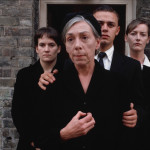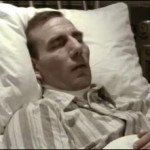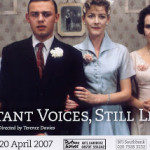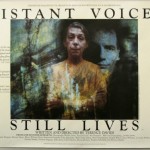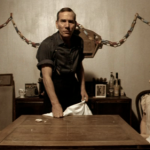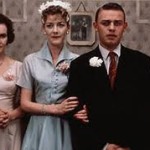Distant Voices, Still Lives: First part of Terence Davies’s fictionalised retelling of his own Liverpool childhood, told in a searing, stylised, fragmented kaleidoscope of memories. Broadly captured in two halves, the first concerning the brutal father, brilliantly played by Pete Postlethwaite, the second lingering on the pub and the songs as the home of the community, its glue. Stunning cinema.
Davies chose to tell the story of his childhood in a trilogy, using a fragmented style to rip apart the key themes. DVSL is heavily stylised, focusing on key encounters and symbolic objects and especially music. It is split into two halves, being, respectively, Distant Voices and Still Lives.
Distant Voices is a fractured collision of post-war memories of the brutal patriarch with a human side, played with chilling effectiveness by the late great Pete Postlethwaite, as if down an echo chamber. The man is domineering, proud and violent with equal measure, and then, dying in hospital, ultimately pathetic. The pathos speaks for itself, yet the scene is played out without emotional manipulation, but is all the more tear-jerking for that simplicity, the washed-out sepia colours, the jumble of mixed emotions, typified by the eldest child, Eileen, crying bitterly at her wedding that she wished her dad was there, while the other siblings, Tony and Maisie, keep smiling but hated the bastard.
By contrast, Still Lives captures life after his demise, how normal working class life went on in the communities of Liverpool, centred on the pubs where entertainment was an evening drinking and singing in the days before universal TV, often thanks to Eileen’s friend Micky (Debi Jones). Nothing much changes, but the natural buoyancy of the people mean that they stay positive and upbeat in spite of everything, encouraged by the more hopeful times in the late 50s.
Interestingly, the locations were chosen with care but were not original – indeed, the principle house used was in London rather than Liverpool, chosen for its similarity to the street in Liverpool where Davies grew up. As Davies himself puts it:
The house where I grew up was demolished in 1961. And it was unique… I was able to rebuild it for The Long Day Closes, but we didn’t have a huge budget for Distant Voices, Still Lives, so we had to find something that looked… working class. A working-class street, and we shot in Drayton Park, but there were no cellars, so it wasn’t like our house… We had to go with what was there, because we didn’t have the money. So that was a practical thing.
That the effect of the photography, acting and music combines to mesmerising effect, in spite of the lack of a narrative structure, is told by this fact, courtesy of Wikipedia:
In a 2011 poll carried out by Time Out Magazine of the 100 greatest British films of all time, Distant Voices, Still Lives was 3rd, a sign of the influence it has had.
I remember vividly seeing this movie for the first time, back in the late 80s. To coin a phrase, I was “gobsmacked” both by the physical and verbal violence and by the compassion Davies shows for his family and community, in spite of everything. This is a must-see movie, showing the reality we don’t wish to remember.



